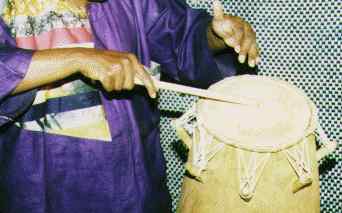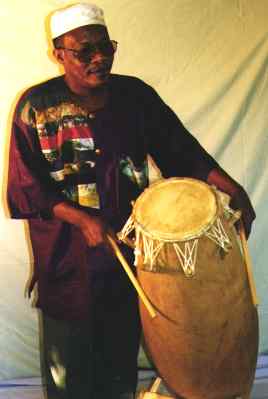Pitch "De", "Te" and "Ge"
Basic Stick Technique
In the understanding of a drummer, a drumming stick is an extension of the hand. It remains under constant control in order to release only the desired frequency of vibration as it strikes the membrane.
There are four types of stick drumming techniques in the art of master drumming, a basic technique and three variants of this technique. Each of these techniques produces a distinct pitch of the Atsimevu pitch series.
The basic stick technique produces a middle range pitch referred to in vocal syllables as "De, "Te" and "Ge". This is achieved by delivering a shot which rebounds after striking the exact center of the drum head, allowing the membrane to vibrate in its entirety. The syllables "De" and "Te" are normally assigned to strokes delivered by the strong hand and "Ge" is assigned to strokes produced by the weak hand. (The vocal syllables De and Te are used interchangeably)
Pitch "De", "Te" and "Ge"
Basic Stick Technique
Pitch: "Tsi"
An alternate stick-shot, approximately half the intensity of the stroke producing the pitch "De", allows only a partial vibration of the membrane by pressing the stick firmly on the drum head, at the center, as the shot is delivered. This technique produces a high range pitch known in vocal syllable as "Tsi".

Pitch "Tsi"
Alternate Stick Technique
Pitch: "To"
Delivering a stick-shot with the strong hand which rebounds after striking the center of the drum while damping the membrane by pressing it firmly at the periphery with the fingers of the weak hand produces a high range pitch known in vocal syllable as "To".
Pitch "To"
Variant Stick Technique
Pitch "Ka"
The final stick drumming technique does not utilize the drum head as the source of resonating the vibration. It strikes the expanded middle section of the cylindrical body known in the Ewe language (vegbe) as vukogo to produce an intense clap-like sound of high pitch described in vocal syllable as "Ka". In the performance of this technique, the impact of the pitch is normally reinforced by preventing the stick from bouncing as the stroke is delivered by pressing it firmly against the cylindrical body.

Pitch "Ka"
Vukogo Stick Technique
Combined Techniques
Pitches: "Dza" and "Dzi"
The pitch "Ka" is quite distinct from the rest of the other pitches for which the membrane is utilized as the initial source of vibration. Its intense clap-like sound can be clearly heard, in its primary role, intensifying the flavor and character of the drum music which is an orderly sequence of pitches in time known in the Ewe musical tradition as vugbe (drum speech).
In another important application, the pitch "Ka" is commonly used to accentuate other pitches to produce denser variants of those pitches. In this application, the pitch "Ka" is performed by the strong hand accentuating the pitches "Ga" and "Ki" played by the weak hand.
The pitch "Ga" played simultaneously with the pitch "Ka" produces a denser low pitch variant spoken in vocal syllable as "Dza".
Pitch "Dza"
Combined Techniques of Bare Hand and Stick
Accentuating the high pitch "Ki" with the pitch "Ka" produces a denser high pitch variant known in vocal syllable as "Dzi".
Pitch "Dzi"
Combined Techniques of Fingers and Stick
The above pitches constitute the entire range of Atsimevu's useful sounds. However, there are some additional modifying terms that are used to indicate the rate of speed with which some tones are connected with one another. For example, in a segment exploiting the pitches "De" to "Ge" occurring at a duration faster than the rhythmic motion of the basic pulsation expressing the character of the main beat, the vocal syllable "Gle" is used to describe the total occurrence of the two sounds. In a similar manner, the syllable "Vlo" is used to describe the occurrence of the pitches "Gi" to "De" at a rate of speed faster than the rhythmic motion of the basic pulsation.
In another modifying term, the phoneme"n" is added at the end of a tone to indicate a short duration of about one pulsation of the basic rhythmic motion. For example, the tone "Te" modified as "Ten" is an indication that the duration of the resonance is controlled to last for about one pulsation of the basic rhythmic motion. The drum is a surrogate for the human voice, and this action is the equivalent of closing the mouth.
In terms of a performance technique, the duration of resonance of a tone is normally controlled by damping the membrane at the periphery with a light but firm touch of the weak hand fingers. This technique is of prime importance in the articulation of the structure of a drum music or vugbe. It provides the means of indicating the basic motives, phrases and periods out of which the drum music is made.
WebMastering
by
and